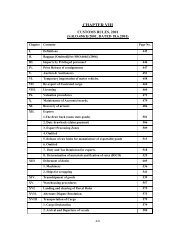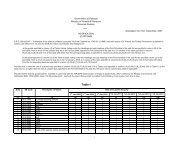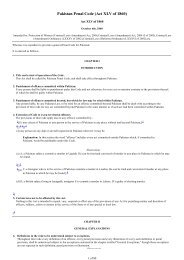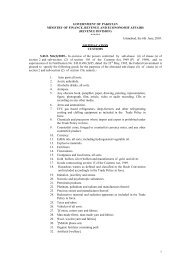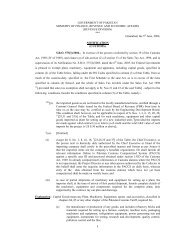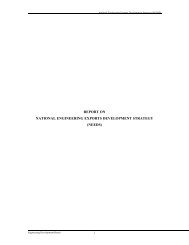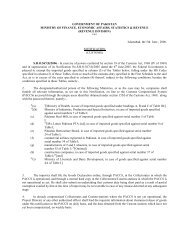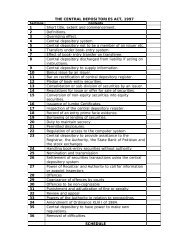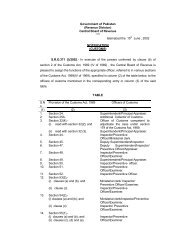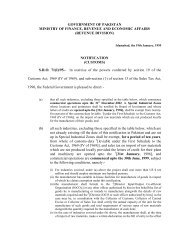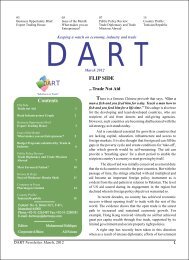47. Pakistan Economic Survey 2011-12 - Consultancy Services in ...
47. Pakistan Economic Survey 2011-12 - Consultancy Services in ...
47. Pakistan Economic Survey 2011-12 - Consultancy Services in ...
Create successful ePaper yourself
Turn your PDF publications into a flip-book with our unique Google optimized e-Paper software.
<strong>Pakistan</strong> <strong>Economic</strong> <strong>Survey</strong> <strong>2011</strong>-<strong>12</strong>To <strong>in</strong>tegrate climate change policy with other related national policiesTo facilitate and strengthen <strong>Pakistan</strong>’s role as a responsible member of the <strong>in</strong>ternational community <strong>in</strong>address<strong>in</strong>g climate change challengesTo focus on pro-poor gender sensitive adaptation while also promot<strong>in</strong>g mitigation to the extent possible <strong>in</strong> acost effective mannerTo ensure water, food, and energy security of the country <strong>in</strong> the face of challenges posed by climate changeTo m<strong>in</strong>imize the risks aris<strong>in</strong>g from expected <strong>in</strong>crease <strong>in</strong> frequency and <strong>in</strong>tensity of extreme events: floods,droughts, tropical storms, etc.To strengthen <strong>in</strong>ter-m<strong>in</strong>isterial and <strong>in</strong>ter-prov<strong>in</strong>cial decision mak<strong>in</strong>g and coord<strong>in</strong>ation mechanism on climatechangeTo facilitate effective use of the opportunities, particularly f<strong>in</strong>ancial, available both nationally and<strong>in</strong>ternationallyTo foster the development of appropriate economic <strong>in</strong>centives to encourage public and private sector <strong>in</strong>vestment<strong>in</strong> both adaptation and mitigation measuresTo enhance the awareness, skill and <strong>in</strong>stitutional capacity of relevant stakeholdersTo promote conservation of natural resources and long term susta<strong>in</strong>abilityThe climate change threats to <strong>Pakistan</strong> are:Considerable <strong>in</strong>crease <strong>in</strong> frequency and <strong>in</strong>tensity of extreme weather events, coupled with erratic monsoon ra<strong>in</strong>scaus<strong>in</strong>g frequent and <strong>in</strong>tense floods and droughtsProjected recession of H<strong>in</strong>du Kush-Karakoram-Himalayan (HKH) glaciers due to global warm<strong>in</strong>g and carbonsoot deposits from trans-boundary pollution sources, threaten<strong>in</strong>g water <strong>in</strong>flows <strong>in</strong>to Indus River System (IRS)Increased siltation of major dams caused by more frequent and <strong>in</strong>tense floodsIncreased temperature result<strong>in</strong>g <strong>in</strong> enhanced heat- and water-stressed conditions, particularly <strong>in</strong> arid and semiaridregions, lead<strong>in</strong>g to reduced agricultural productivityFurther decrease <strong>in</strong> the already scanty forest cover from too rapid change <strong>in</strong> climatic conditions to allow naturalmigration of adversely affected plant speciesIncreased <strong>in</strong>trusion of sal<strong>in</strong>e water <strong>in</strong> the Indus delta, adversely affect<strong>in</strong>g coastal agriculture, mangroves andbreed<strong>in</strong>g grounds of fishThreat to coastal areas due to projected sea level rise and <strong>in</strong>creased cyclonic activity due to higher sea surfacetemperaturesIncreased stress between upper riparian and lower riparian regions on shar<strong>in</strong>g the water resourcesIncreased health risks and climate change <strong>in</strong>duced migrationThe above threats are the cause of major survival concerns for <strong>Pakistan</strong>, particularly <strong>in</strong> terms of the country’swater, food, and energy security considerationsState of the EnvironmentAirWith an estimated 37 percent of its populationliv<strong>in</strong>g <strong>in</strong> cities, <strong>Pakistan</strong> is the most urbanizedcountry <strong>in</strong> South Asia. Rapid urbanization has beenaccompanied by environmental problems such aspollution, waste management, congestion and thedestruction of fragile ecosystems. Urban airpollution rema<strong>in</strong>s one of the most significantenvironmental problems fac<strong>in</strong>g cities. A substantialbody of research demonstrates that highconcentrations of suspended particulate matteradversely affect human health; prolong a widerange of respiratory diseases and <strong>in</strong>creases theprobability of heart ailments.The higher concentration of Suspended ParticulateMatter (SPM) <strong>in</strong> the air is a major issue <strong>in</strong><strong>Pakistan</strong>. The ma<strong>in</strong> sources of SPM are vehicularemission, <strong>in</strong>dustrial emissions, burn<strong>in</strong>g of solidwaste, pollens, brick kilns and natural dust.SPM can orig<strong>in</strong>ate through natural phenomenon,such as unpaved roads and places uncovered byComment [MM3]: chapter on laborforce/population mentions that urban unemploymenthigher than rural.238



